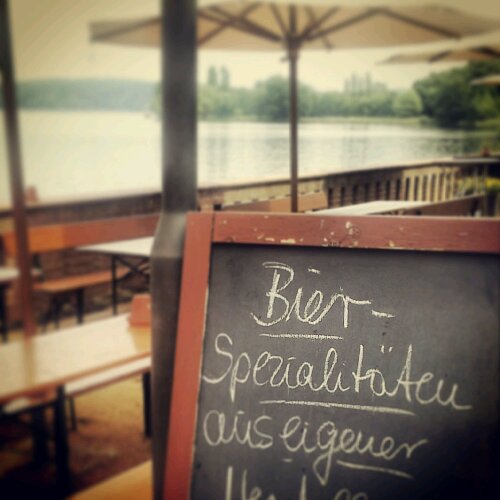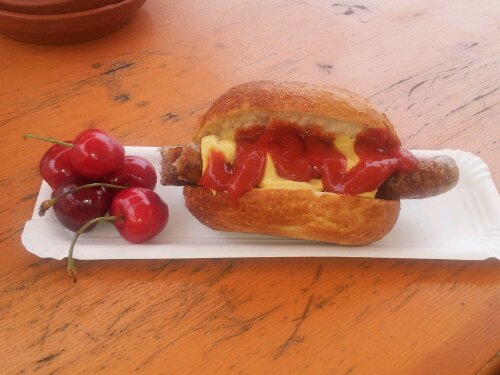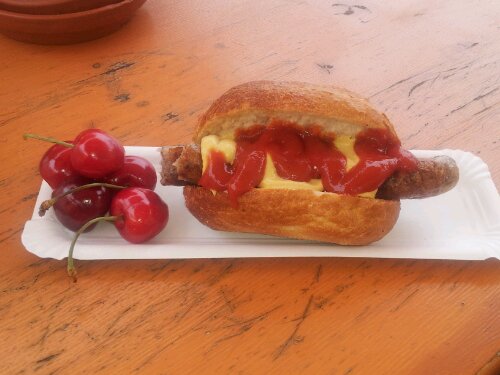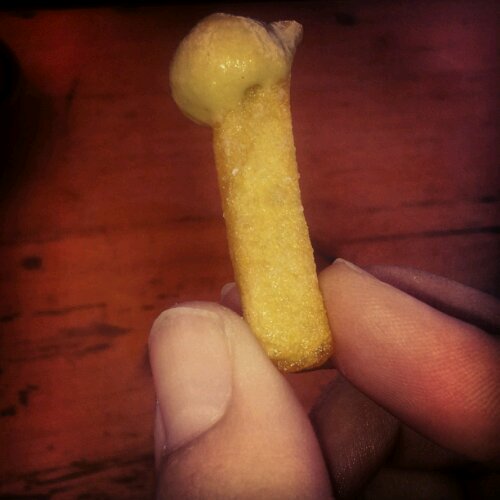
As an amateur sausage maker myself, I was pretty pumped about my first Brat in Podstam, Germany. While wandering through the small, but incredibly pleasant town of Potsdam, I read the words “Bier SpezialitoAeu” and B-lined over to the spot I assumed was a Beer Garden. I nearly fell to my knees in praise and exhaustion when I rounded the corner to find open umbrellas lining a lake and a small service window in a brick wall inviting me to feast on freshly cased brats. Mind you, I have just walked what seemed like a double marathon around this town because my new travel buddy and I opted out of the guided tour bus. (We’re far too cool to be super tourists. If I got on that bus, I might as well velcro on a fanny pack and tighten my umbrella hat.) Before reaching the garden I stopped at a fruit stand where I bought cherries, carrots, and apples for the journey. I didn’t realize how quickly your body can burn through fruits and veggies when hiking, but I was sincerely jonesing for some meat. So I ordered “ein Bratwurst und frites” in my best German accent. The young lady immediately responded in English, “Sure, 3 euros.” I was surprised to see the brat was long and thin, cut in half and stacked vertically in a small bun. In the US, our brats are nearly bursting at the seams and only 4 inches long. I must admit, I was almost disappointed the sausage wasn’t the mighty father of links I anticipated, and seemed moderately colorless in comparison to the sage and fennel seed filled wieners we know and love back home.
Never. Ever. Judge a book by its cover.
This succulent, double-stacked, salty, juicy, creamy, tenderly cased meat sent a dribble of drool down my chin with the first bite. I took a huge bite without bread or condiments to appreciate the intentional marrying of flavors. Amazing. In case you imagine all sausage as one, I’ll give you a brief idea of what sets a brat apart from other popular links like polska kielbasa or andouille. I have actually made Bratwurst three times now, each recipe different. The consistent ingredient, however is heavy cream. Traditionally Brats are made with equal parts pork and veal, with 1/3 part fatback from the pig. I have learned through trial and error that the inclusion of fatback is important since veal is fairly lean. The most consistent ingredient in Bratwurst, that dare not be altered, excluded, or substituted for in any way, is the heavy cream. It adds another level of fat to the meat that holds a richness that can come from no other ingredient. The cream simultaneously sweetens the meat, enhances the herbs and tones down the acidity from the vinegar that is added to most brats in the precasing-stage.
This bratwurst was in every way, aside from preconceived ideas of size, exactly what a brat should be. It was juicy, dripping with molten fatback. Tender with a natural casing that tore easily. The grain was medium and the butcher was obviously careful not to emulsify the meat. (An art that is quite difficult to perfect.) It was slightly sweet, with a creamy texture. Just perfect.
The pommes were quite simply chunky potato straws fried golden and salted. Plain and appreciated by all cultures. The only reason I purchased these sticks of starch was to have an instrument to serve as a shovel for the most decadent mustard I’ve ever consumed. Most folks who know me, know that I love all breeds of mustard. French’s classic, honey mustard, grey poupon, spicy brown, beer whole grain… you get it. I love the stuff. I naturally expected the world’s greatest mustard to hail from France, but Germany has set the bar fairly high. The mustard was a classic dijon, rich with horseradish and slightly breathtaking. I felt silly for not even considering divine mustard could come from the place known for great sausage. For could there be a better match in the culinary world of soulmates than mustard and bratwurst? A question for the ages.



Yum. And your detailed description made my mouth see fireworks.
Now I’m hungry. And there is nothing wrong with the umbrella hat….practical use meets whimsical design 🙂
Oops. I’ve revealed “your way home team” as my sinister alter-ego. Insert evil laugh {here}.
Haha now we know